
Gospel originally meant the Christian message, but in the 2nd century it came to be used also for the books in which the message was set out. In this sense a gospel can be defined as a loose-knit, episodic narrative of the words and deeds of Jesus, culminating in his trial and death and concluding with various reports of his post-resurrection appearances. Modern scholars are cautious of relying on the gospels uncritically, but nevertheless, they provide a good idea of the public career of Jesus, and critical study can attempt to distinguish the original ideas of Jesus from those of the later authors.
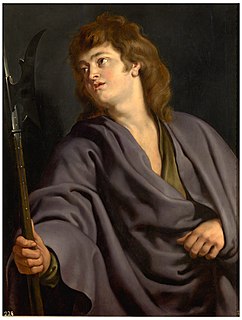
Matthew the Apostle, also known as Saint Matthew and possibly as Levi, was, according to the New Testament, one of the twelve apostles of Jesus. According to Christian traditions, he was also one of the four Evangelists as author of the Gospel of Matthew, and thus is also known as Matthew the Evangelist, a claim rejected by most biblical scholars, though the "traditional authorship still has its defenders."

The Roman Empire was the post-Republican period of ancient Rome. As a polity, it included large territorial holdings around the Mediterranean Sea in Europe, North Africa, and Western Asia, ruled by emperors. From the accession of Caesar Augustus as the first Roman emperor to the military anarchy of the 3rd century, it was a principate with Italy as the metropole of its provinces and the city of Rome as its sole capital. The Empire was later ruled by multiple emperors who shared control over the Western Roman Empire and the Eastern Roman Empire. The City of Rome remained the nominal capital of both parts until AD 476 when the imperial insignia were sent to Constantinople following the capture of the Western capital of Ravenna by the Germanic barbarians. The adoption of Christianity as the state church of the Roman Empire in AD 380 and the fall of the Western Roman Empire to Germanic kings conventionally marks the end of classical antiquity and the beginning of the Middle Ages. Because of these events, along with the gradual Hellenization of the Eastern Roman Empire, historians distinguish the medieval Roman Empire that remained in the Eastern provinces as the Byzantine Empire.
The 20s decade ran from January 1, AD 20, to December 31, AD 29.

Marcian was Roman emperor of the East from 450 to 457. Very little of his life before becoming emperor is known, other than that he was a domesticus who served under the commanders Ardabur and his son Aspar for fifteen years. After the death of Emperor Theodosius II on 28 July 450, Marcian was made a candidate for the throne by Aspar, who held much influence because of his military power. After a month of negotiations Pulcheria, Theodosius' sister, agreed to marry Marcian. Zeno, a military leader whose influence was similar to Aspar's, may have been involved in these negotiations, as he was given the high-ranking court title of patrician upon Marcian's accession. Marcian was elected and inaugurated on 25 August 450.

A satrap was a governor of the provinces of the ancient Median and Achaemenid Empires and in several of their successors, such as in the Sasanian Empire and the Hellenistic empires.
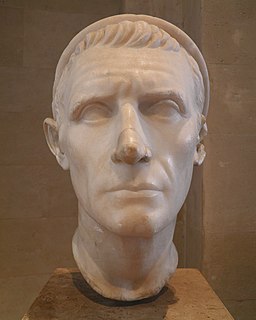
Antiochus III the Great was a Greek Hellenistic king and the 6th ruler of the Seleucid Empire, reigning from 222 to 187 BC. He ruled over the region of Syria and large parts of the rest of western Asia towards the end of the 3rd century BC. Rising to the throne at the age of eighteen in 222 BC, his early campaigns against the Ptolemaic Kingdom were unsuccessful, but in the following years Antiochus gained several military victories and substantially expanded the empire's territory. His traditional designation, the Great, reflects an epithet he assumed. He also assumed the title Basileus Megas, the traditional title of the Persian kings. A militarily active ruler, Antiochus restored much of the territory of the Seleucid Empire, before suffering a serious setback, towards the end of his reign, in his war against Rome.
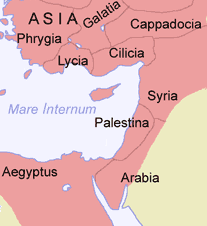
Syria Palaestina was the name of a Roman province in the Southern Levant region between the early 2nd and late 4th centuries CE. It succeeded the earlier province of Judaea, which was renamed at around the time of the Bar Kokhba revolt in 132-136 CE. Its capital was Caesarea Maritima.

Aerarium, from aes + -ārium, was the name given in Ancient Rome to the public treasury, and in a secondary sense to the public finances.

The cursus publicus was the state mandated and supervised courier and transportation service of the Roman Empire, later inherited by the Eastern Roman Empire. It was a system based on obligations placed on private persons by the Roman State. As contractors, called mancipes, they provided the equipment, animals, and wagons. In the Early Empire compensation had to be paid but this had fallen into abeyance in Late Antiquity when maintenance was charged to the inhabitants along the routes. The service contained only those personnel necessary for administration and operation. These included veterinarians, wagon-wrights, and grooms. The couriers and wagon drivers did not belong to the service: whether public servants or private individuals, they used facilities requisitioned from local individuals and communities. The costs in Late Antiquity were charged to the provincials as part of the provincial tax obligations in the form of a liturgy/munus on private individual taxpayers.
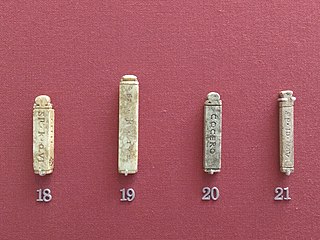
The practices of Ancient Roman finance, while originally rooted in Greek models, evolved in the second century BC with the expansion of Roman monetization. Roman elites engaged in private lending for various purposes, and various banking models arose to serve different lending needs.
Walter Brueggemann is an American Protestant Old Testament scholar and theologian who is widely considered one of the most influential Old Testament scholars of the last several decades. He is an important figure in modern progressive Christianity whose work often focuses on the Hebrew prophetic tradition and sociopolitical imagination of the Church. He argues that the Church must provide a counter-narrative to the dominant forces of consumerism, militarism, and nationalism.

The study of the Roman economy, which is, the economies of the ancient city-state of Rome and its empire during the Republican and Imperial periods remains highly speculative. There are no surviving records of business and government accounts, such as detailed reports of tax revenues, and few literary sources regarding economic activity. Instead, the study of this ancient economy is today mainly based on the surviving archeological and literary evidence that allow researchers to form conjectures based on comparisons with other more recent pre-industrial economies.
Samuel George Frederick Brandon was a British Anglican priest and scholar of comparative religion. He became professor of comparative religion at the University of Manchester in 1951.

In the early Roman Empire, from 30 BC to AD 212, a peregrinus was a free provincial subject of the Empire who was not a Roman citizen. Peregrini constituted the vast majority of the Empire's inhabitants in the 1st and 2nd centuries AD. In AD 212, all free inhabitants of the Empire were granted citizenship by the Constitutio Antoniniana, with the exception of the dediticii, people who had become subject to Rome through surrender in war, and freed slaves.
Procurator was a title of certain officials in ancient Rome who were in charge of the financial affairs of a province, or imperial governor of a minor province.

Christianity in the 1st century covers the formative history of Christianity from the start of the ministry of Jesus to the death of the last of the Twelve Apostles and is thus also known as the Apostolic Age. Early Christianity developed out of the eschatological ministry of Jesus. Subsequent to Jesus' death, his earliest followers formed an apocalyptic messianic Jewish sect during the late Second Temple period of the 1st century. Initially believing that Jesus' resurrection was the start of the end time, their beliefs soon changed in the expected Second Coming of Jesus and the start of God's Kingdom at a later point in time.
In Ancient Rome, Tributum was a tax imposed on the citizenry to fund the costs of war. The Tributum was one of the central reasons for the conducting of the census on assets, as it rose with wealth. It included cash assets, land, property and moveable goods. Several types of tributum have been attested to, including tributum in capita, tributum temerarium, and tributum ex censu.
There were four primary kinds of taxation in ancient Rome: a cattle tax, a land tax, customs, and a tax on the profits of any profession. These taxes were typically collected by local aristocrats. The Roman state would set a fixed amount of money each region needed to provide in taxes, and the local officials would decide who paid the taxes and how much they paid. Once collected the taxes would be used to fund the military, create public works, establish trade networks, stimulate the economy, and to fund the cursus publicum.
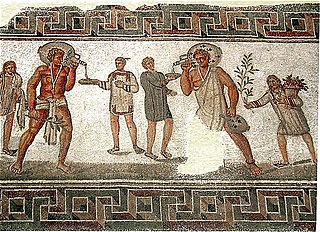
The Vicesima libertatis, also known as the Vicesima Manumissionum was an ancient Republican Roman tax on freed slaves. If the master freed the slave the government would tax the master for 5% of the slaves value. If the slave freed themselves they would be taxed. Another possibility is that the tax was for registering a slave as free, not for freeing them in the first place. It was established in 357 BCE by the Consul Gnaeus Manlius. There is no archaeological evidence for this tax in all provinces except for Italy before the Severan dynasty.













